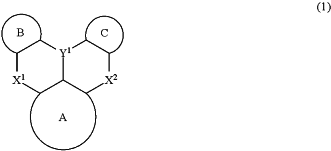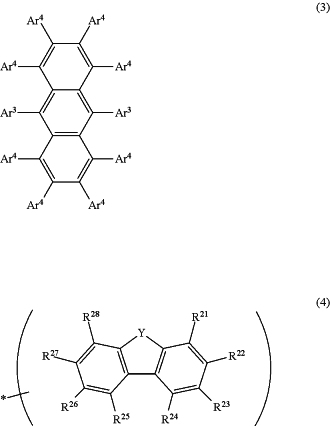| CPC H10K 85/322 (2023.02) [C07D 209/80 (2013.01); C07D 209/86 (2013.01); C07D 307/77 (2013.01); C07D 307/91 (2013.01); C07D 333/76 (2013.01); C07F 5/027 (2013.01); C09K 11/02 (2013.01); C09K 11/06 (2013.01); H10K 50/00 (2023.02); H10K 50/16 (2023.02); H10K 85/615 (2023.02); H10K 85/631 (2023.02); H10K 85/636 (2023.02); H10K 85/657 (2023.02); H10K 85/6572 (2023.02); H10K 85/6574 (2023.02); H10K 85/6576 (2023.02); C07F 5/02 (2013.01); C09K 2211/1007 (2013.01); C09K 2211/1014 (2013.01); C09K 2211/1096 (2013.01); H10K 50/11 (2023.02); H10K 50/156 (2023.02); H10K 50/165 (2023.02); H10K 50/166 (2023.02); H10K 50/171 (2023.02)] | 9 Claims |
|
1. An organic electroluminescent element comprising a pair of electrodes composed of a positive electrode and a negative electrode and a light emitting layer disposed between the pair of electrodes, in which
the light emitting layer comprises at least one of a polycyclic aromatic compound represented by the following general formula (1) and a polycyclic aromatic compound multimer having a plurality of structures represented by the following general formula (1), and an anthracene-based compound represented by the following general formula (3)
 in the above formula (1),
ring A, ring B and ring C each independently represent an aryl ring or a heteroaryl ring, while at least one hydrogen atom in these rings may be substituted,
Y1 represents B,
X1 and X2 each independently represent N—R, R of the N—R is an optionally substituted aryl, an optionally substituted heteroaryl or alkyl, R of the N—R may be bonded to the ring A, ring B, and/or ring C with a linking group or a single bond, and
at least one hydrogen atom in a compound or a structure represented by formula (1) may be substituted by a halogen atom or a deuterium atom
 in the above formula (3),
Ar3 and Ar4 each independently represent a hydrogen atom, an optionally substituted alkyl, an optionally substituted aryl, an optionally substituted heteroaryl, an optionally substituted alkoxy, an optionally substituted aryloxy, an optionally substituted arylthio, a trialkylsilyl, an optionally substituted amino, a halogen atom, a hydroxy, or a cyano, provided that a naphthyl group and a naphthyl group fused with one benzene ring are excluded as Ar3,
at least one hydrogen atom of a compound represented by formula (3) may be substituted by a deuterium atom,
at least one hydrogen atom of a compound represented by formula (3) is substituted by a group represented by the above formula (4),
Y represents —O—, —S— or >N—R29 in the above formula (4), R21 to R28 each independently represent a hydrogen atom, an optionally substituted alkyl, an optionally substituted aryl, an optionally substituted heteroaryl, an optionally substituted alkoxy, an optionally substituted aryloxy, an optionally substituted arylthio, a trialkylsilyl, an optionally substituted amino, a halogen atom, a hydroxy, or a cyano, adjacent groups among R21 to R28 may be bonded to each other to form a hydrocarbon ring, an aryl ring, or a heteroaryl ring, R29 is an optionally substituted aryl or a bonding position with a compound represented by formula (3), and a group represented by formula (4) is substituted by at least one hydrogen atom in a compound represented by formula (3) at *, and is bonded thereto at any position in a structure of formula (4).
|